

The Flywheel Philosophy. Réviser votre stratégie, c'est payant! - JPD Conseil - LA société conseil des PME. Your Company’s Purpose Isn’t to Save the World. I recently came across a press release touting a company’s brand purpose statement, which promises that its products will raise the quality of life for all people, all over the world.
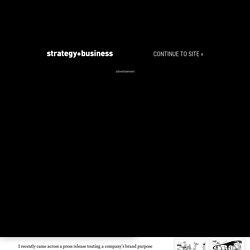
The idea that any company could actually do this, though, strikes me as fundamentally unrealistic and just seems like an attempt to jump on the change-the-world bandwagon, which has become a popular thing to do as employees increasingly expect employers to prioritize social responsibility. But organizations that overreach with simplistic, empty pledges are missing the point of what a purpose statement should be.
I’ve spent five decades working with brands, helping organizations achieve greater recognition and relevance. What Would It Take to Get Businesses to Focus Less on Shareholder Value? How an industry CEO approaches insurance strategy. Deanna Mulligan, president and CEO of Guardian Life Insurance, reflects on how she approaches strategy planning in an industry with strong headwinds.
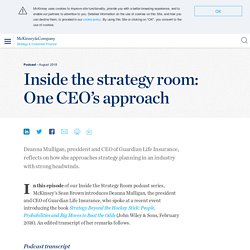
In this episode of our Inside the Strategy Room podcast series, McKinsey’s Sean Brown introduces Deanna Mulligan, the president and CEO of Guardian Life Insurance, who spoke at a recent event introducing the book Strategy Beyond the Hockey Stick: People, Probabilities and Big Moves to Beat the Odds (John Wiley & Sons, February 2018). An edited transcript of her remarks follows. Podcast transcript Audio. Warren Buffett and Jamie Dimon join forces to convince CEOs to end quarterly profit forecasts. Long-term Thinking Is Your Best Short-term Strategy - Executive Education. Profit vs purpose: friends not foes - Korn Ferry Focus. 3 Tactics That Will Improve Execution Immediately - Execution is the lifeblood of your business.
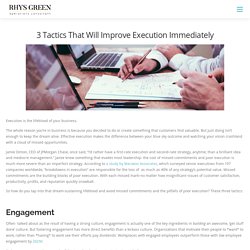
The whole reason you’re in business is because you decided to do or create something that customers find valuable. But just doing isn’t enough to keep the dream alive. Effective execution makes the difference between your blue sky outcome and watching your vision crashland with a cloud of missed opportunities. Jamie Dimon, CEO of JPMorgan Chase, once said, “I’d rather have a first-rate execution and second-rate strategy, anytime, than a brilliant idea and mediocre management.” Jamie knew something that evades most leadership: the cost of missed commitments and poor execution is much more severe than an imperfect strategy. So how do you tap into that dream-sustaining lifeblood and avoid missed commitments and the pitfalls of poor execution?
Engagement Often talked about as the result of having a strong culture, engagement is actually one of the key ingredients in building an awesome, ‘get stuff done’ culture. Accountability Recognition. Have you tested your strategy lately? Research: We Take More Risks When We Compete Against Rivals. The Adpative Strategy Framework. How do things become strategic? ‘Strategifying’ corporate social responsibility - Jean-Pascal Gond, Laure Cabantous, Frédéric Krikorian, 2018.
Abstract How do things become ‘strategic’?

Despite the development of strategy-as-practice studies and the recognized institutional importance of strategy as a social practice, little is known about how strategy boundaries change within organizations. This article focuses on this gap by conceptualizing ‘strategifying’ – or making something strategic – as a type of institutional work that builds on the institution of strategy to change the boundaries of what is regarded as strategy within organizations. We empirically investigate how corporate social responsibility has been turned into strategy at a UK electricity company, EnergyCorp. Author biographies Jean-Pascal Gond is a Professor of Corporate Social Responsibility (CSR) at Cass Business School, City, University of London (UK). Laure Cabantous is a Professor of Strategy and Organization at Cass Business School, City, University of London.
Strategy & Corporate Finance. June 14, 2018 – By Chris Bradley As anyone who writes a book can attest, it’s both gratifying and nerve-racking to see how the ideas resonate with your readers.
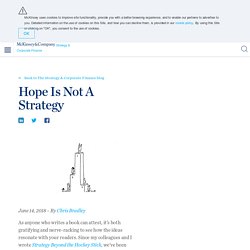
Since my colleagues and I wrote Strategy Beyond the Hockey Stick, we’ve been circling the globe discussing the research with the media, at conferences and, most importantly, with business leaders. Perhaps the finding that generates the biggest reaction is just how uneven business performance is. What game theory teaches us about war. The Death of Supply Chain Management. Leading for the long term. Successful CEOs combine winning strategies with compelling stories and constructive engagement with shareholders.
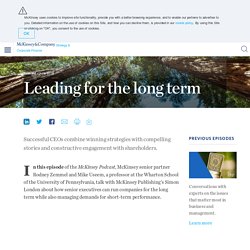
In this episode of the McKinsey Podcast, McKinsey senior partner Rodney Zemmel and Mike Useem, a professor at the Wharton School of the University of Pennsylvania, talk with McKinsey Publishing’s Simon London about how senior executives can run companies for the long term while also managing demands for short-term performance. Five Fifty: Going long. Eight shifts that will take your strategy into high gear. Developing a great strategy starts with changing the dynamics in your strategy room.
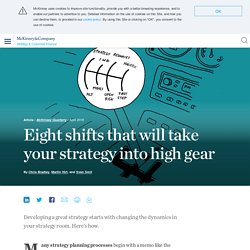
Here’s how. Many strategy planning processes begin with a memo like the one below. Such missives lead managers to spend months gathering inputs, mining data, scanning the marketplace for opportunities and threats, and formulating responses. In the strategy meetings that follow, the CEO leads discussions, executives jockey for resources, and a strategy emerges that confidently projects future growth. The budget is set—and then nothing much happens. So much activity, so little to show for it. We summarized many of those core findings in a recent McKinsey Quarterly article. 1. Have you tested your strategy lately? Strategy Beyond the Hockey Stick: People, Probabilities, and Big Moves to Beat the Odds (2018) by Chris Bradley, Martin Hirt and Sven Smit. With Goals, FAST Beats SMART.
To execute strategy, leaders must set ambitious targets, translate them into specific metrics and milestones, make them transparent throughout the organization, and discuss progress frequently. In 1954, management guru Peter Drucker introduced “management by objectives,” an approach where employees would agree with their boss on a set of goals and work toward achieving those objectives throughout the year.1 Not even a visionary like Drucker, however, could have predicted how thoroughly goals would come to dominate the modern workplace. In 95% of organizations, according to a recent survey, employees set goals for themselves or their teams.2 When it comes to setting goals, most managers follow a well-established set of practices. The conventional wisdom of goal setting is so deeply ingrained that managers rarely stop to ask a fundamental question — does it work?
If the traditional approach to goals cannot ensure successful strategy execution, what’s the alternative? Make Goals Transparent. An alternative approach to building a strategic plan for businesses. How can companies direct attention toward initiatives that have the most impact—and ensure that they’re properly funded?

Using two parallel time horizons—one that’s six to 12 months out and another that’s 10 to 20 years—can help boost immediate strategic impact and prepare for the long term. Introduction: Achieving impact that matters today With change and performance pressure only accelerating, it may be time to reassess how we approach strategy. Traditional approaches don’t account for the increasing pace of change and risk generating diminishing returns or missing the mark entirely. Fortunately, there is a more promising way to address the challenges ahead.
Go Long: Why Long-Term Thinking Is Your Best Short-Term Strategy (2018) by Dennis Carey, Brian Dumaine, Michael Useem and Rodney Zemmel. Reviving High-Touch Business Models for the Social Distancing Era. The demand for many products and services has evaporated over the past several months as consumers have altered their typical patterns while adhering to stay-at-home orders and social distancing practices.

But a unique set of businesses that may evoke feelings of nostalgia for some — including milk and frozen-food delivery services, and drive-in theaters — are attracting renewed interest. Such business models were quite prominent in the past but fell out of favor due to excessive costs, inconvenient distribution, or changes in consumer behavior. In the current era of social distancing, however, their high-touch, high-contact features are very desirable. This article documents the resurgence of interest in high-touch businesses, provides specific “old made new” questions to help professionals illuminate creative value propositions their companies can pursue, and describes how technology can enhance a full-service approach. Research Updates From MIT SMR Please enter a valid email address.
Tactics without strategy is a scrum. Eight shifts that will take your strategy into high gear. Corporate Sustainability at a Crossroads. About the Authors: David Kiron is the executive editor of MIT Sloan Management Review.

He can be contacted at dkiron@mit.edu. Gregory Unruh is the Arison Professor of Values Leadership at George Mason University and guest editor for MIT SMR’s Big Idea sustainability initiative. He can be contacted at gregoryunruh@gmail.com. Nina Kruschwitz is the former senior project manager of MIT Sloan Management Review. Martin Reeves is a senior partner and managing director in The Boston Consulting Group’s New York office and head of BCG’s Henderson Institute. Holger Rubel is a senior partner and managing director and global sustainability lead in The Boston Consulting Group’s Frankfurt office.
Why even bother to think about strategy? There's confusion between tactics and strategy. It's easy to get tied up in semantic knots as you work to figure out the distinction. It's worth it, though, because strategy can save you when tactics fail. It’s Time for Companies to Imbed Social Purpose in their Business Strategy. The power of purpose. The Role of Change Management in Strategy - Lean Methods Group. By David Silverstein How many times have we heard it? “We had a good strategy, but we didn’t manage the change very well.” You know what we say to that? Consider how complete your strategy was in the first place; if it didn’t account for the challenge of effective change management, was it a good strategy to begin with?
Eight shifts that will take your strategy into high gear. Strategy to beat the odds. Why digital strategies fail. Most digital strategies don’t reflect how digital is changing economic fundamentals, industry dynamics, or what it means to compete. Companies should watch out for five pitfalls. No One Knows Your Strategy — Not Even Your Top Leaders. How to Develop Strategy for Execution. Effective strategic guidelines get three things right. They link to the corporate vision, identify critical vulnerabilities, and focus on what matters most. Strategy is not about choice, it’s about choices. Few companies succeed based on a single big bet. Four Logics of Corporate Strategy. Organizations often struggle with corporate strategy because executives lack clarity on how parts of the business fit together to create and capture economic value. How to Recognize a Strategic Priority When You See One. A company’s financial reports can provide critical insights into its strategy — if you know where to look.
As part of our research on strategy for execution, we analyzed how large, publicly traded companies described their strategy in public documents. Turning Strategy Into Results. The rise of the social enterprise. Strategic Change Is All in the Timing. Want A Purpose-Driven Business? Know The Difference Between Mission An. Over the past decade, leaders in business, education, and the social sector have become more interested in the development of purpose.
Leading social entrepreneurship incubator Echoing Green hosted a movement-building Purpose Summit, the John Templeton Foundation sponsored a nationwide scholarship program to encourage youth to write purpose-inspired college essays, and the AARP began a big push to encourage “encore” purpose-focused second careers. Despite this increased focus on purpose, our organizations are sorely lacking leaders who are aware of and deeply connected to the purpose behind their work. Turning Strategy Into Results. 21st Century Manufacturing Enterprise Strategy: An Industry-Led View (1992) by Roger N. Nagel, Iacocca Institute, Lehigh University. More and More CEOs Are Taking Their Social Responsibility Seriously. Delivering Value in Smaller Increments: Different Ways to Thin Slice Your Minimum Viable Product - Agile by Design Inc. At its core, organizations are demonstrating meaningful business agility when they are able to deliver value to the market in progressively smaller increments, minimizing the delay required to gather market and customer feedback.
Marketing Stratégique : Ambidextrie organisationnelle. Four Logics of Corporate Strategy. The Strategic Agility Project.